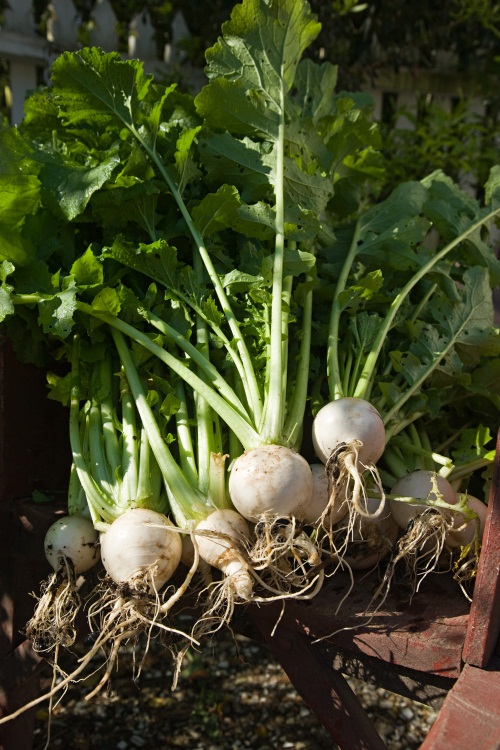gathering turnip greens
This week we have conducted the final thinning in the turnip rows. This not only ensures a crop of well-formed roots but provides the finest turnip greens of the year. While I am a great admirer of greens in general, turnip greens, other than these tender young seedlings, are apt to become coarse and rank. There are many who will disagree and it is certain that the manner of preparation determines the delicacy of the dish, but full grown turnip leaves are best left for the cattle. Indeed, many hundreds of acres of turnips are grown for livestock in colonial Virginia.
As to the thinning, some varieties of turnip, such as the common Purple Top, are fairly tolerant of crowding. Others, such as the White Egg, will produce very few well-rounded turnips if they are not well thinned. Ideally each root should be spaced six inches from its neighbor, but if you are scanty in regard to your land, four inches will suffice.

White egg turnip
While the Purple Top is the variety most commonly found in the modern garden, there are others, more delicate in flavor, to consider. The White Egg turnip is similar to the white Dutch described by James Justice in 1771, “Chiefly used in this country for early crops, and for eating raw in May and June, of which many are very fond.” I find this turnip to be of exceptional flavor, when eaten raw, and can be served in thin slices on hors d’oeuvres plates with a bit of dressing.
While some declare that the best turnips are grown in a poor, gravelly soil, we have found that a fertile loam serves best. As the estimable John Rutter observed in 1767, “No root rewards the gardener’s care better than the turnep; for its excellence depends more than all others upon culture, and will be proportioned in goodness to the attention shewn in its growth.
For a complete discussion of the several varieties of turnips you are invited to consult, Vegetable Gardening the Colonial Williamsburg Way, 18th Century Methods for Today’s Organic Gardeners (Rodale Press).

Leave a Reply